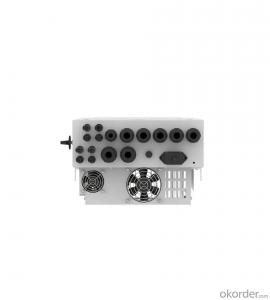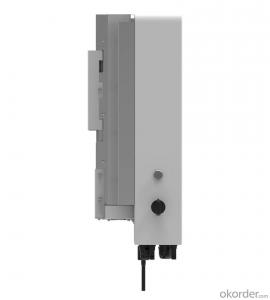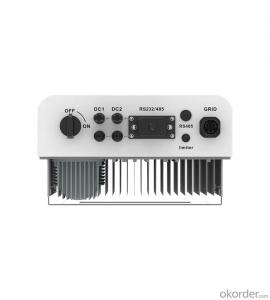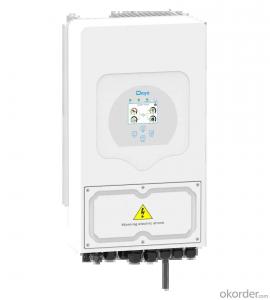Solar Inverter for Home - sun-3.6/5/6/7.6/8k-sg05lp1-eu 3.6-8kW Single Phase | 2 MPPT | Hybrid Inverter | Low Voltage Battery
- Loading Port:
- Ningbo
- Payment Terms:
- TT OR LC
- Min Order Qty:
- 100 pc
- Supply Capability:
- 5000 pc/month
OKorder Service Pledge
OKorder Financial Service
You Might Also Like
Specification
| Technical Data | |||||||
| Model | SUN-3.6K -SG05LP1-EU | SUN-5K -SG05LP1-EU | SUN-6K -SG05LP1-EU | SUN-7.6K -SG05LP1-EU | SUN-8K -SG05LP1-EU | ||
| Battery Input Data | |||||||
| Battery Type | Lead-acid or Li-lon | ||||||
| Battery Voltage Range (V) | 40~60 | ||||||
| Max. Charging Current (A) | 90 | 120 | 135 | 190 | 190 | ||
| Max. Discharging Current (A) | 90 | 120 | 135 | 190 | 190 | ||
| External Temperature Sensor | Yes | ||||||
| Charging Curve | 3 Stages / Equalization | ||||||
| Charging Strategy for Li-Ion Battery | Self-adaption to BMS | ||||||
| PV String Input Data | |||||||
| Max. DC Input Power (W) | 4680 | 6500 | 7800 | 9880 | 10400 | ||
| Rated PV Input Voltage (V) | 370 (125~500) | ||||||
| Start-up Voltage (V) | 125 | ||||||
| MPPT Voltage Range (V) | 150-425 | ||||||
| Full Load DC Voltage Range (V) | 300-425 | 200-425 | |||||
| PV Input Current (A) | 13+13 | 26+26 | |||||
| Max. PV ISC (A) | 17+17 | 34+34 | |||||
| No.of MPP Trackers | 2 | ||||||
| No.of Strings per MPP Tracker | 1 | 2 | |||||
| AC Output Data | |||||||
| Rated AC Output and UPS Power (W) | 3600 | 5000 | 6000 | 7600 | 8000 | ||
| Max. AC Output Power (W) | 3690 | 5500 | 6600 | 8360 | 8800 | ||
| AC Output Rated Current (A) | 16.4/15.7 | 22.7/21.7 | 27.3/26.1 | 34.5/33 | 36.4/34.8 | ||
| Max. AC Current (A) | 18/17.2 | 25/23.9 | 30/28.7 | 38/36.3 | 40/38.3 | ||
| Max. Continuous AC Passthrough (A) | 35 | 40 | 50 | ||||
| Peak Power (off grid) | 2 time of rated power, 10 S | ||||||
| Power Factor | 0.8 leading to 0.8 lagging | ||||||
| Output Frequency and Voltage | 50/60Hz; L/N/PE 220/230Vac (single phase) | ||||||
| Grid Type | Single Phase | ||||||
| DC injection current (mA) | THD<3% (Linear load<1.5%) | ||||||
| Efficiency | |||||||
| Max. Efficiency | 0.976 | ||||||
| Euro Efficiency | 0.965 | ||||||
| MPPT Efficiency | 0.999 | ||||||
| Protection | |||||||
| Integrated | PV Input Lightning Protection, Anti-islanding Protection, PV String Input Reverse Polarity Protection, Insulation Resistor Detection, Residual Current Monitoring Unit, Output Over Current Protection, Output Shorted Protection, Surge protection | ||||||
| Output Over Voltage Protection | DC Type II/AC Type III | ||||||
| Certifications and Standards | |||||||
| Grid Regulation | CEI 0-21, VDE-AR-N 4105, NRS 097, IEC 62116, IEC 61727, G99, G98, VDE 0126-1-1, RD 1699, C10-11 | ||||||
| Safety EMC / Standard | IEC/EN 61000-6-1/2/3/4, IEC/EN 62109-1, IEC/EN 62109-2 | ||||||
| General Data | |||||||
| Operating Temperature Range (℃) | -40~60℃, >45℃ derating | ||||||
| Cooling | Natural cooling | ||||||
| Noise (dB) | <30 dB | ||||||
| Communication with BMS | RS485; CAN | ||||||
| Size (mm) | 330W x 580H x232D | ||||||
| Protection Degree | IP65 | ||||||
| Installation Style | Wall-mounted | ||||||
| Warranty | 5 years | ||||||
| Weight (kg) | 24 | ||||||
Colorful touch LCD, IP65 protection degree
6 time periods for battery charging/discharging
Max. charging/discharging current of 120A
Max.16pcs parallel
DC couple and AC couple to retrofit existing solar system
Support storing energy from diesel generator
48V low voltage battery, safe and reliable
Unique Smart Load application and Grid peak shaving function 4ms fast transfer from on-grid to off-grid mode, ensuing the traditional fixed frequency air conditioner works well
SUN 3.6/8K-SG05,hybrid inverter, is suitable for residential and light commercial use, maximizing self-consumption rate of solar energy and increasing your energy impendence. During the day, the PV system generates electricity which will be provided to the loads initially. Then, the excess energy will charge the battery via SUN 3.6/8K-SG05. Finally, the stored energy can be released when the loads require it. The battery can also be charged by the diesel generator to ensure uninterrupted supply in the event of grid blackout.
It equipped with RS485/CAN port for battery communication
- Q: What is the maximum temperature range for a solar inverter?
- The maximum temperature range for a solar inverter typically varies between -25°C to 60°C (-13°F to 140°F).
- Q: How does a solar inverter handle voltage sags or swells in the grid?
- A solar inverter handles voltage sags or swells in the grid by continuously monitoring the grid voltage. When a sag or swell is detected, the inverter adjusts its output voltage accordingly to maintain a stable and consistent supply of power. It does this by regulating the amount of power it injects into the grid or by temporarily disconnecting from the grid to protect itself and other connected devices. This helps to prevent damage to the inverter and ensures that the solar system can continue operating efficiently even during voltage fluctuations.
- Q: Can a solar inverter be used with other renewable energy sources like wind or hydro power?
- Yes, a solar inverter can be used with other renewable energy sources like wind or hydro power. Inverters are designed to convert the direct current (DC) generated by these renewable sources into alternating current (AC) that can be used to power homes or businesses. By integrating multiple renewable energy sources through a single inverter, it becomes possible to create a more diverse and reliable renewable energy system.
- Q: How does a solar inverter handle voltage regulation during fault conditions?
- During fault conditions, a solar inverter typically handles voltage regulation through various protective and control mechanisms. It may employ techniques such as voltage regulation algorithms, fast response times, and fault detection systems. These measures help the inverter to rapidly detect and respond to fault conditions by adjusting its output voltage to maintain stability within safe limits. Additionally, some inverters may also incorporate features like overvoltage protection, under-voltage protection, and anti-islanding functionality to further ensure safe and reliable operation during fault conditions.
- Q: Can a solar inverter be used with different types of grid connection standards?
- Yes, a solar inverter can be used with different types of grid connection standards. Solar inverters are designed to convert the direct current (DC) produced by solar panels into alternating current (AC) that is compatible with the electrical grid. They are versatile and can be programmed to work with various grid connection standards, such as single-phase or three-phase systems, different voltage levels, and frequency requirements. This allows solar inverters to be used in a wide range of grid configurations, making them adaptable to different regions and grid infrastructure.
- Q: How does a solar inverter affect the voltage stability of a solar system?
- A solar inverter plays a critical role in maintaining voltage stability in a solar system. It converts the direct current (DC) generated by solar panels into alternating current (AC) which is suitable for use in our homes and businesses. By regulating and adjusting the voltage levels, a solar inverter ensures that the power generated by the solar panels matches the required voltage of the electrical grid. This helps to maintain a steady and stable voltage output, preventing fluctuations and ensuring the smooth functioning of the solar system.
- Q: What is the role of a voltage regulator in a solar inverter?
- The role of a voltage regulator in a solar inverter is to maintain a consistent and stable output voltage despite fluctuations in the input voltage from the solar panels. It ensures that the electricity generated by the solar panels is converted and delivered to the connected devices or grid at the required voltage level, preventing any damage to the devices and optimizing the overall efficiency of the solar power system.
- Q: How does a solar inverter communicate with monitoring systems?
- A solar inverter communicates with monitoring systems through various means such as wireless technologies like Wi-Fi, Bluetooth, or Zigbee, or through wired connections like Ethernet or RS485. These communication channels allow the inverter to transmit important data and performance metrics to the monitoring systems in real-time.
- Q: How does a solar inverter affect the overall efficiency of a solar system?
- A solar inverter plays a crucial role in the overall efficiency of a solar system. It converts the direct current (DC) generated by solar panels into alternating current (AC) that can be used to power household or commercial appliances. By ensuring optimal conversion efficiency and minimizing power losses during this process, a high-quality solar inverter can significantly impact the overall efficiency of a solar system.
- Q: Are there any safety considerations when installing a solar inverter?
- Yes, there are several safety considerations when installing a solar inverter. Firstly, it is important to ensure that the inverter is installed by a qualified professional who is familiar with local electrical codes and regulations. This helps to minimize the risk of electrical hazards and ensures a safe installation. Additionally, proper grounding and bonding should be implemented to protect against electrical shock and lightning strikes. Adequate ventilation and temperature management are also important to prevent overheating and potential fire hazards. Overall, following safety guidelines and employing professional installation services are crucial to ensure the safe and efficient operation of a solar inverter system.
Send your message to us
Solar Inverter for Home - sun-3.6/5/6/7.6/8k-sg05lp1-eu 3.6-8kW Single Phase | 2 MPPT | Hybrid Inverter | Low Voltage Battery
- Loading Port:
- Ningbo
- Payment Terms:
- TT OR LC
- Min Order Qty:
- 100 pc
- Supply Capability:
- 5000 pc/month
OKorder Service Pledge
OKorder Financial Service
Similar products
Hot products
Hot Searches
Related keywords






























